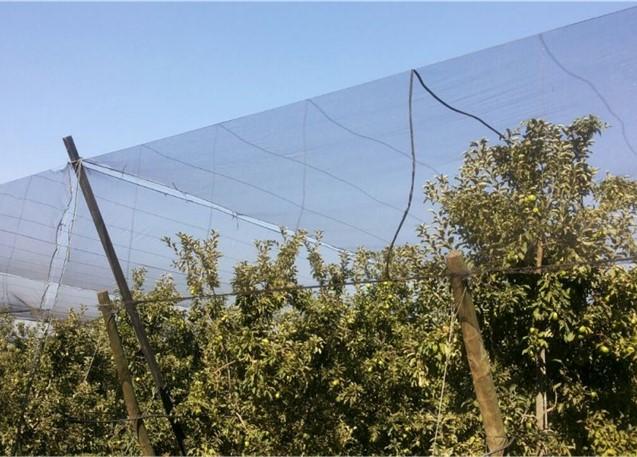Sunburn in apples: Why does it occur and how can it be prevented?
What is sunburn and why does it occur?

Sunburn on apples is an irreversible damage that occurs to the fruit (Fig. 1). Apples are susceptible to sunburn from 38-40 mm fruit diameter, i.e., the size of a golf ball. Sunburn can be caused by heat or light, or both. When heat is the cause, ambient air temperature is not as important as fruit surface temperature. Each variety has its own threshold fruit surface temperature for sunburn to occur. Some varieties, such as Cripps Pink, require a very high fruit surface temperature for damage to develop, something like 120° F. Other varieties have a much lower threshold. For example, sunburn occurs on Cameo when the fruit surface temperature reaches 115° F. Factors such as low humidity and wind speed, combined with high solar radiation and temperature, can also be important contributors to the development of sunburn in apples.
In general, developing fruits cannot dissipate excess solar radiation and temperature, as tree leaves can, so the surface temperature of the fruit can reach 50° F to 60° F higher than the air.
How can sunburn in apples be prevented?
To mitigate sunburn in apples, there are several strategies that can be implemented:
Protective nets:
These correspond to polyethylene nets that are positioned in the canopy of the trees in order to provide shade (Fig. 2) . There are several types of nets that allow choosing the intensity and type of light radiation that will reach the fruit, in order to avoid burns. This strategy decreases solar radiation, the temperature of the fruit surface, as well as wind speed. It can also increase the relative humidity of the soil. In addition, these nets can protect trees and fruit from birds and hail.
However, the cost of these protective nets can be very high and the installation of these nets can be labor intensive. In addition, one must be very careful in the type of netting to select since it must be compatible with the specific variety of apple and with the environmental conditions in which the orchard is located.
Overhead Evaporative Cooling:
It refers to irrigation on the surface of the tree that is applied in different cycles so as to make the fruit become wet and then allow it to dry. The latent heat produced is used to evaporate the water to help cool the fruit. This strategy reduces the surface temperature of the fruit and thus the susceptibility to sunburn, but it must be managed correctly to be effective. It has been found that the use of evaporative cooling can also increase the sugar content of the fruit and in some varieties can also help improve the red skin color of apples.
It is important to note that evaporative cooling does not protect apples from light radiation (specifically ultraviolet radiation). In addition, this system can also be costly to set up and requires constant maintenance. Its effectiveness is based on the management of the irrigation system, the volume of irrigation and the temperature of the water applied. Many times the salts coming from the water can cause burns on the leaves of the trees.
Sunscreen/ Sunblock:
In order to protect apples from sunburn, sunblock can be applied to them. This consists of compounds with chemical agents and inorganic components that dissipate high intensity light, thus blocking and scattering high light radiation. This strategy is highly efficient when combined with evaporative cooling, since the sunscreen protects the fruit from radiation, while evaporative cooling reduces the fruit surface temperature. Sunscreen does not leave residues that require washing off, is non-toxic and does not affect the development of red color in apple skin.
Sunscreen alone cannot be used as protection against sunburn on apples and must be applied periodically to keep the surface of the fruit covered.
Particle films:
This strategy corresponds to the use of white particles such as Surround (Kaolin clay), and the calcium carbonates like PurShade that are applied directly to the fruit. These particles are capable of blocking, reflecting and scattering solar radiation and heat reaching the surface of the fruit and leaves. They are able to improve light distribution within the canopy and reduce fruit surface temperature. These will typically reduce sunburn incidence by up to 50%. In general, it is less expensive than protective netting and evaporative cooling.
However, it should be taken into consideration that particle films leave residues that are often difficult to remove and must be washed off. In addition, constant applications are required to maintain proper adhesion of the particle films to the fruit surface. Under heavy splotches and droplets, the fruit develops a mottled appearance.
This article appears in June 2023, Volume 14, Issue 4 of the Vegetable and Fruit News.
